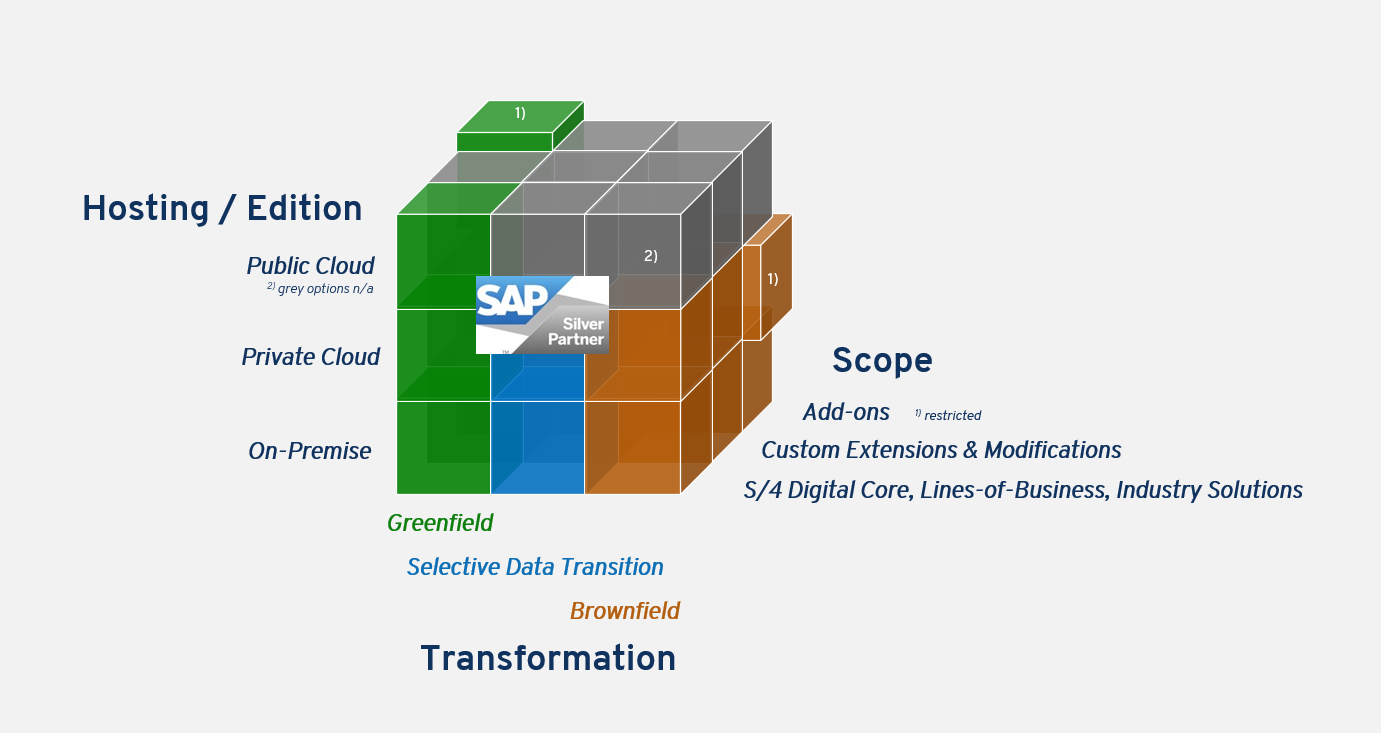Are you currently challenged with the decision to implement SAP S/4HANA or to transform your existing SAP ECC application landscape to SAP S/4HANA? Then you - like many other customers - are probably looking for guidance to structure the decision alternatives.
Based on our experience, three dimensions determine your transformation strategy to S/4HANA in terms of time, budget and flexibility:
- Scope
- Hosting / Edition
- Transformation Path
With our S/4HANA strategy cube, we visualize the decision space and also highlight which combinations are not compatible to each other.
In the Scope dimension, you determine the components you will use to implement the required functionalities in your future ERP architecture. SAP S/4HANA already covers the essential business processes with the Digital Core. In addition, the Lines-of-Business Solutions offer further in-depth functionalities for supporting functions (e.g., purchasing) as well as Industry Solutions already tailored to the specific needs of an industry within the SAP standard. Based on our experience, you should first evaluate these and only consider Custom Extensions or Add-Ons available from third-party providers for specific processes if these standard extensions do not cover your requirements.
The well-fitting SAP S/4HANA hosting model
SAP S/4HANA is offered in various hosting models and you determine which S/4HANA edition is suitable for you in the Hosting / Edition dimension. In the Public-Cloud-Edition, you receive a fully cloud-based, modern ERP solution as software-as-a-service and thus achieve not only a low TCO but also continuous access to further developments and innovations. This is always possible if your processes do not differ from the standardized best practice processes of SAP S/4HANA or if you are flexible to adapt in that area.
In addition, SAP also offers a Private Cloud Edition next to the already existing On-Premise-Edition. In our view, these no longer differ significantly in terms of functionality, and both provide an ideal starting point for global companies - with the provision of a wide range of country versions and support for industry specifics. However, they differ significantly in regards of the hosting model. Customers who want to retain complete control over their ERP system and data and run the solution themselves in their own data center opt for the On-Premise-Edition. Customers who want to combine the advantages of the low TCO of an ERP solution hosted in the cloud with a certain degree of customizability and extension of the standard as well as a somewhat more flexible import of upgrades & patches opt for the Private-Cloud-Edition.
Decision on the right transformation path
Finally, in the Transformation dimension, you make the decision about the transformation path that is right for you. Quite a few companies that, after years of mergers & acquisitions, continuous custom development and customizing, are faced with a somewhat highly individualized application architecture far from the SAP standard, opt for a complete redesign of ERP processes based on a clean, latest-generation ERP template as part of a greenfield approach to throw old burdens overboard.
This contrasts with the purely technical conversion of your existing SAP system to S/4HANA as part of a brownfield approach. Here, the goal is often not to enrich the system with new functionalities and to use the new features of S/4HANA, but rather to lift the existing business processes onto a new technical basis in order to achieve a long-term compatible ERP system -technically up-to-date- without a complete new implementation ("upgrade").
Often, however, organizational adjustments shall also to be implemented as part of an upgrade to S/4HANA (e.g., mergers or separation of organizational units) or data needs to be selectively transferred and/or transformed. Approaches for Selective Data Transformation are available for this purpose, either by SAP SE itself or by third-party providers. These are used to implement functional or organizational adjustments in addition to the technical upgrade to S/4HANA.
Make the right decisions
The three dimensions of “Scope”, “Hosting/Edition” and “Transformation path” provide a decision space with different combinations of decisions in these three areas. However it is important for you to consider that not all combinations are possible. Also here the model of our S/4HANA strategy cube helps you to highlight the valid decision alternatives. The invalid ones are directly grayed out in the cube. Here are two examples:
-
Transformation Path: All three transformation paths are possible for the On-Premise and Private Cloud version. However the Public Cloud edition can only be implemented with a greenfield approach.
-
Custom Code: Custom developments are possible in the On-Premise and Private Cloud editions, but you do not have this option in the Public Cloud.
You can use this cube representation to systematize the possible decision alternatives for your company in advance. We will be happy to support you with this, define your individual transformation path to S/4HANA and work with you to develop your target architecture and prepare the ERP strategy and roadmap tailored to your customer situation.
We would be happy to go into greater depth with you also on other topics that you should consider as part of your S/4HANA migration strategy:
-
Accelerators: Which approach and solutions can I use to shorten my implementation project and make it more efficient?
-
RISE with SAP: Is this more than a license conversion? Which services are included and which are not? Who provides these services and what does this mean for your specific situation?
-
Custom Code: How do I handle custom code that I need to re-use after S/4HANA is implemented?
-
Customer-Vendor-Integration: Planning the cleansing and synchronization of the customer and vendor base as a preliminary project.
-
NewGL: Implementation of the new General Ledger as a pre-project or during the S/4HANA project (possibly third-party vendors required for support).
-
Customer Service: Existing CS functions in ECC will be replaced or complemented by new cloud solutions in many areas. Customers using maintenance and more complex service processes will have to create a new development plan here.
-
Manufacturing: SAP will provide a large number of new functions in various cloud solutions (e.g. Manufacturing Execution, Engineering Cloud). A new enterprise architecture and roadmap can lead to many usage and efficiency benefits.
-
Human Capital Management: Classic ECC topics are shifting more and more towards the cloud. With the growing functionality in SuccessFactors, SAP HR Suite customers should also drive a capability approach for their HR processes to develop a functional migration strategy.
-
Suite on HANA: Converting the database only to SAP HANA as an intermediate step before implementing S/4HANA with new functionality?
Contact
AdEx Partners supports you in defining the holistic S/4HANA migration approach based on understanding the business objectives, assessing the as-is and required business capabilities, defining the required ERP architecture, and translating it into your strategic roadmap for the future solution with SAP S/4HANA.
Feel free to contact us! We are happy to support you in that!






![Marco Weber [Translate to English:] Marco Weber AdEx Partners](/fileadmin/_processed_/a/f/csm_Marco_Weber_AdEx_Partners_9b48af843c.jpg)